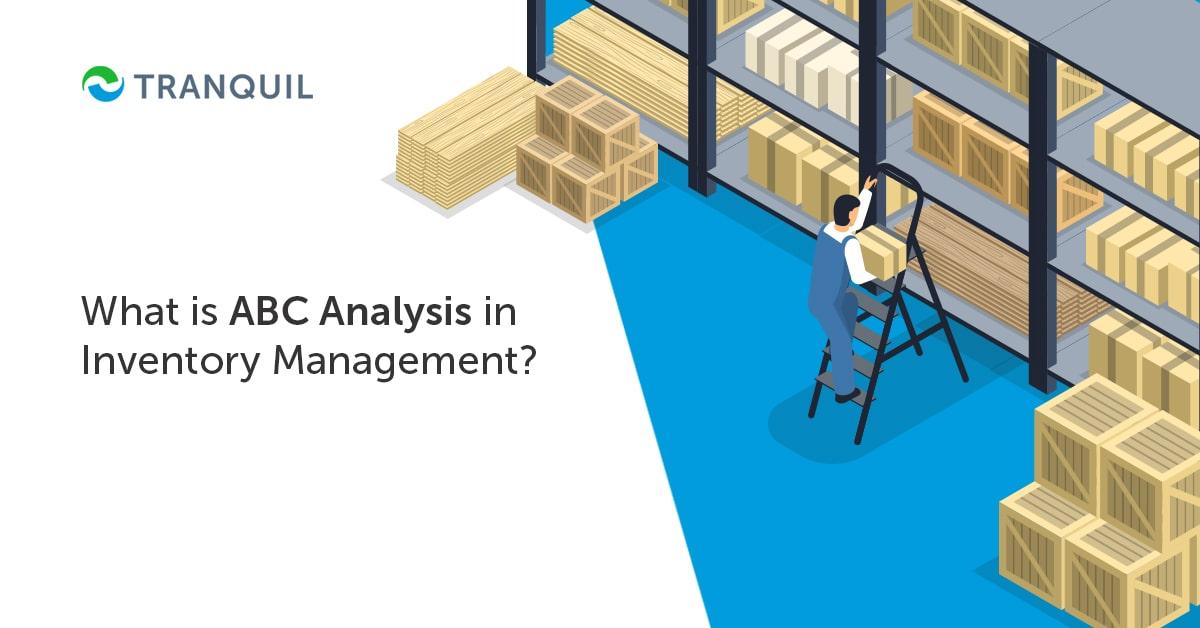
What is ABC Analysis in Inventory Management?
Most businesses have hundreds of inventory items that have been purchased from a few dozen vendors at least; these are shipped or sold to thousands of customers.
The larger the business, the more complex this equation.
Managing inventory of this complexity in an efficient way necessitates the use of smart strategies which help assign priorities.
The ABC analysis in inventory management is one such strategy or model, and it is also referred to as ABC Inventory Classification.
ALSO READ: Common Inventory Management Mistakes to Avoid
What is ABC Inventory Analysis?
ABC inventory analysis is a method of inventory management whereby the Inventory team classifies inventory items into three categories: A, B, and C.
The items are categorized according to their value or importance to the business.
It is a simple and easy method and helps managers to concentrate their efforts on controlling important inventory items more efficiently.
They can implement different inventory control strategies for the three categories so that they hold optimal levels of each inventory item.
ABC Analysis to Control Inventory

The different Stock Keeping Units or SKUs in any business have different values.
While some items may be highly profitable, others may not be, but they may be necessary as an accessory or complementary to another, and so on. Some items may necessitate meticulous management, replenishment, and forecasting.
Therefore, by segmenting all inventory items into A, B, or C, it becomes easy to discover which items need to be managed more efficiently.
Inventory is usually prioritized as per sales or consumption in production (usage value).
The formula to calculate usage value is: usage rate x individual value OR sales volume x unit cost.
Therefore, if 50 units each costing 70 are sold, the usage value will be 50 x 70 = 3500.
The most important and critical items which require the strictest control are classified as A.
Items less important than A, are classified as B.
The least important items are classified as C; they require much lesser attention than A and B category items.
ALSO READ: What is Inventory Cycle Counting?
ABC Analysis Of Inventory Control and the 80/20 Rule
The 80/20 rule is also called the Pareto Principle; it simply means that a small number of inventory items make up the major usage value.
‘A’ classified inventory items are 20% of the items in the inventory but they have the highest usage value – around 80% of the total usage value of the business.
‘B’ classified items that make up about 30% of the inventory items and have usage of about, 10% of the total usage value.
‘C’ classified items make up the rest of the inventory and account for only 10% of the usage value.
Other Types of ABC Analysis Criteria
Apart from usage value, there are types of ABC analysis; of course, usage value is the most popular method.
Inventory items can also be classified according to various operational criteria, like:
- Uncertain supply – items with sudden spikes and dips in demand
- Obsolescence risk – the risk of the item deteriorating or going out of vogue
- Stockout risk – the possibility of the item getting stocked out
- Stockout consequences – the impact on production or customer service due to the item being stocked out
ALSO READ: What is Zero Inventory? Advantages, Drawbacks
The Importance and Advantages of ABC Analysis

After performing the ABC analysis and categorizing all the items into A, B, or C, you have to use this information to make your inventory control and management more efficient.
Let’s look at the advantages offered by this method:
1. Accurate Demand Forecast
Inventory planners can leverage the ABC analysis to forecast the sales of various products, and accordingly manage those inventories.
This can help reduce the holding cost for dead stock or obsolete stock, enhancing your supply chain management.
2. Improves Time Management
The inventory team can focus mainly on Category A items to ensure optimal availability of those items.
This may include a more frequent review of stock levels, updating of sales forecasts, or increased interaction with suppliers to reduce lead times.
3. Develop Custom Inventory Rules
Once you categorize all your inventory into different categories, you can implement tailored strategies to manage each category.
You can establish separate reorder levels and parameters, safety stock levels, and service levels for each category.
Let us say, that by altering the safety stock or reorder quantities of category A items, you can save significantly on the cost; and an improvement in its fulfilment rates may help increase overall availability greatly.
ALSO READ: What is Pipeline Inventory and Decoupling Inventory?
4. Strategic Pricing
For products that deliver maximum value to your company, you can leverage ABC analysis to optimize the pricing strategy.
By knowing the in-demand products, you can increase the selling price for those, and boost your profitability immensely.
5. Informed Supplier Negotiations
We have seen that businesses earn nearly 80% of their revenue from Category A inventory items.
It makes good business sense to negotiate with vendors for better prices for those items as you purchase a good quantity of those items.
You can also negotiate for reduced down payments, lower or free shipping, or reduced cost of other post-purchase services.
ALSO READ: How Can you Track UOM?
6. Strategic Resource Allocation
Through continuous evaluation of the resources allocated, you can ensure that you always have those items in Category A, that align with customer demand.
When demand reduces, you can reassign them to either B or C, and bring the in-demand items into A.
7. Improved Customer Service
Service levels are dependent on several factors including profit margins, cost of the item, and the quantity sold.
When you know the most profitable items, you can offer the best service levels for them.
8. Better Product Life Cycle Management
You get crucial insights about the stage of a given product in its life cycle, like launch, maturity, waning etc.; this can help you to forecast demand and frame your inventory stocking policies accordingly.
ALSO READ: Debit notes Vs Credit Notes
9. Improved Control of High-Value Inventory
Category A inventory significantly contributes to the success of a business.
With ABC analysis you can identify the A category inventory items in real time and keep track of the demand for those items to make sure you always carry adequate stock.
By focusing your energies on inventory that is a high priority, you increase the chances of succeeding in business.
10. Good Stock Turnover Rate
ABC analysis can help you maintain a good stock turnover rate with the help of data capture and proper inventory control.
11. Lower Storage Expenses
By holding the appropriate level of stocks in each of the three categories, you can decrease the carrying costs that are related to stocking inventory in excess.
ALSO READ: Why ERP User Interfaces are Important?
Disadvantages of ABC analysis

While ABC analysis is an easy and popular way to set priorities for managing the different items in your inventory, as with everything else, there are certain arguments against this method:
Overly Simplified
Some experts opine that ABC analysis makes inventory classification overly simple – and they would not be wrong.
This is especially so when inventory teams perform the classification based not on actual data but on their instincts.
ABC classification is a one-dimensional method, because it does not consider any other factor other than sales value of an inventory item.
Frequency of picking or sales, variation in demand and other factors could be just as important to categorize your inventory items and define the most important items. But these tend to get overlooked when implementing ABC analysis.
Dividing inventory into just three categories robs this method of granularity.
Companies can have thousands of items in a single category; to think that all of those SKUs have the exactly similar characteristics is making too much of a generalization.
ALSO READ: What Every Business Should Know About CPQ?
Static Method
The ABC analysis is not dynamic at all.
Trends emerge and fade frequently in any marketplace, and sales of products can fluctuate wildly.
This means that items could move from one category to another fairly quickly.
Without continuous monitoring and re-classification, your original categorization can become irrelevant and outdated.
For example, your category A products may become category C products, but you may continue to treat them as Category A because you have not monitored inventory and reclassified them.
You could face stockouts of some items and excess inventory of others.
This can harm your business significantly; it can throw your inventory management into disarray and negatively impact your bottom line.
ALSO READ: Guide on Stock Adjustment and Stock Transfer
Time-consuming
As there is the risk of ABC classification becoming outdated in a short time, you need to frequently re-evaluate your categories; and this can take up a lot of time.
Your inventory department may spend too much time in classification rather than taking informed decisions about inventory based on the results of the categorization.
Considering Demand in ABC Analysis

You can take ABC analysis to the next level by cross analyzing the usage value of inventory items with their variability in demand.
This means you will be able to categorize products depending on their value as well as the extent of variance from the demand forecast.
This will give you an idea of how accurately you are able to forecast a specific product or item.
Let us suppose, that some products have regular demand, with others having erratic demand.
These types of insights can help you take informed actions regarding the inventory items to stock, set safety levels, and so on.
ALSO READ: What is Demand Forecasting?
You can also decide to perform the cross analysis of usage value with the frequency of the item’s sale, or picking.
This will help you to prevent stocking items in excess, that are relatively high in value but move only slowly.
You can make sure that items which are relatively low in value but have regular sales are monitored more closely.
Often these supposedly low-value items have high profit margins, and are hence very important – so you need to focus on such items as well.
Automating ABC Inventory Analysis

One of the most effective ways to overcome the gaps in the ABC analysis method, and to use it more efficiently, is by using the right software.
Effective software can analyze and categorize your inventory efficiently and track it round the clock.
ERP solutions like Tranquil allow not just the basics like ABC analysis and XYZ analysis (for demand) but also offer advanced tools – especially customization to optimize your inventory.
You can perform multi-dimensional item classification that takes into account multiple variables, like:
- Annual usage value = volume of sales * per unit cost
- Number of times an item is picked in the course of 12 months
- The number of units sold or the demand volume
- The frequency of sales of an item
ALSO READ: Understanding the Importance of Distribution Management
This allows a sophisticated inventory classification structure that can be used to frame inventory policies.
This includes setting levels of safety stocks and service level targets for every category and filtering down to the level of the SKUs.
These classifications are constantly monitored and updated, and reclassified as and when necessary.
This ensures that the segmentation is always aligned with market dynamics.
A robust ERP solution like Tranquil can help you manage your inventory efficiently, with its robust inventory management module. You can enjoy increased profitability and reduced costs, and prevent lost sales, or excess inventory. Do schedule a demo to see how our software works, and we will be happy to explain how it can benefit your business.



